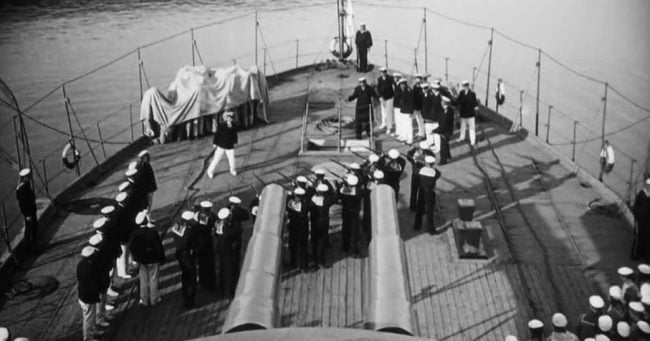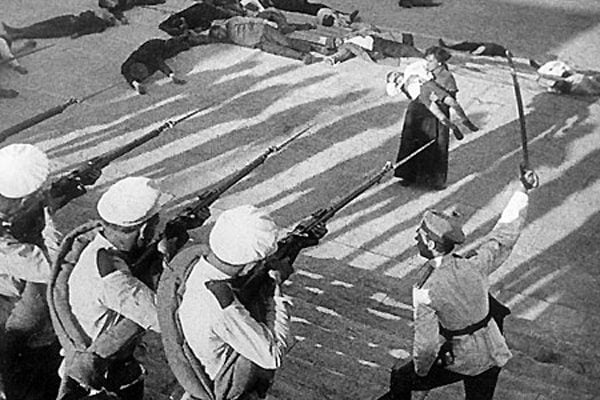Any film buff who has studied film, or even gone to film school has watched Battleship Potemkin. Even though it was made almost 100 years ago, it serves as a reminder of what dedication, passion and hard work can do.
Battleship Potemkin was released as a Soviet silent film in 1925. It was directed by Sergei Eisenstein and written by Nina Agadzhanova, Sergei Eisenstein, Nikolai Aseyev and Sergei Tretyakov. This is one of the most important films in the history of cinema and is British Film Institute’s number 11th greatest film of all time.

The film takes place during the Russian Revolution of 1905 and is loosely about the real-life events of battleship Potemkin’s mutiny of the abusive, tyrannical regime of the ship’s officers.
The importance of this film can be understood through its countless praise. Orson Welles, Michael Mann and Paul Greengrass all said that this was on their lists of favorite films, while Billy Wilder and Charlie Chaplin take it one step further placing this as their favorite film of all time.
So, for those that have never heard of or seen this film, I am sure the question “why is this film so important” is coming to mind. To start with, the film was made with “propaganda” in mind. I know that word has been used so many times but in the early 1900’s, leaders had not really understood the profound effect film could have on a nation, and once they did, propaganda film was born.
A main point that the film attempts to get across is that no one is the “star” of an uprising. There are not many names given (although some are) for both the sailors or officers in the film and one reason for that is to draw a distinct line between the two groups to show that it is not about one specific person, but about the entire group of peoples that need to change. The film is broken down into five different chapters.
Chapter I: Men and Maggots
The first chapter of the film sets the stage for the inhumane treatment of the ship’s men. The officers beat them, feed them maggot infested meat and treat them as if they are nothing more than fodder for war. The men refuse to eat their lunch enraging the officers.
Chapter II: Drama on the Deck
The officers call a meeting for everyone on the deck. When the commander of the ship orders everyone who is okay with the food to step forward, only a few men do so. The commander, now filled with rage, orders some of the men who would not step forward to be shot. When the rifles are lifted however, one man pleads with the riflemen that they are about to shoot their brothers and to take over the ship. The sailors overrun the ship throwing the officers overboard but the man who spoke up, Vakulinchuk, is killed in the process.

Chapter III: A Dead Man Calls Out
During the memorial service of Vakulinchuk, a large crowd gathers learning of the events and making a decision to join the revolution. While this decision is being made, the authorities begin to show up.
Chapter IV: The Odessa Steps
A large crowd gathers at the top of the steps to watch the ship while they send food and supplies ensuring the sailors of the Potemkin that they support their mutiny. While they are doing this however the Tsar’s troops are keeping a watchful eye on them and suddenly decides to open fire on the people of Odessa. In doing so, they slaughter many innocent people and the crew of the Potemkin become overwhelmed with anger and storm the Tsarist headquarters at the local theater.
Chapter V: One Against All
While the crew take the ship out to sea to further the battle there instead of on land in Odessa. While they are doing so, they come head-to-head with the fleet ready to do battle if it comes to it. But when they meet up, they join together in comradery and allow the Potemkin to pass unscathed.
The editing of this film was innovative and changed the way films would be made forever. It is commonplace now for a film to show two separate scenes edited together to force a common theme between them. One of the most famous films to do this was The Godfather, when the baby is being baptized, Michael Corleone is also being “baptized” into the family business. The film is cut in a way where it shows these two separate scenes, joined together in one overarching story. Eisenstein literally wrote the book on different forms of editing. Well, maybe not a book but defiantly an essay. He said that editing different types of a montage is “the nerve of cinema.” He then went on to say that the five kinds of montage editing are Metric, Rhythmic, Tonal, Overtonal, and Intellectual. His practices are still used in cinema today.
The tension building with scene to scene was another revolutionary marvel in the film industry. All though the film is only 71 minutes long, it seems longer due to the scene placement and underlying tension Eisenstein builds through his 1300 different shots. The violent scenes when the innocent lives are taken on the steps actually resulted in the film being banned or censored in many countries for a number of years.
There are many reasons why this film will continue to be one of the most influential films ever made, but the emotion behind the revolution, the editing that took place and the tense action scenes Eisenstein used will go down in history as a cornerstone for film making.
Watch “Battleship Potemkin” on TheLastPicture.Show
Written exclusively for TheLastPicture.Show by Jacob Ruble
Disclosure: The links on this page are “Affiliate Links” and while these are shown at no costs to our viewers, they generate commissions for our website(s)

